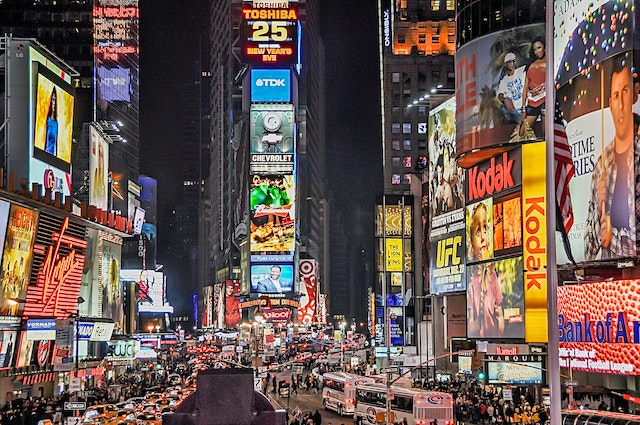Emotional ads tap into underlying feelings and desires that people experience in order to get a response from them. Bandwagon ads on the other hand create a sense of social pressure for people to join in with what everyone else is doing even if they may not fully agree or understand why.
Emotional Advertising
(Photo by Oleksandr Pidvalnyi)

Emotional advertising is a marketing strategy that seeks to elicit strong emotions from consumers in order to create a connection between the consumer and the brand. Emotional advertising often uses storytelling, music, and visual imagery to create an emotional response in the viewer or listener. The emotions evoked can range from happiness and joy to sadness and empathy, and the goal is to create a positive association between the consumer and the brand. Emotional advertising is often used to create a strong brand identity and to differentiate a brand from its competitors.
Bandwagon Advertising
Bandwagon advertising is a marketing strategy that suggests that the consumer should join the crowd and use a particular product or service because it is popular or widely used. This type of advertising often uses slogans such as “Join the thousands who have already switched to our product” or “Everyone is using our service, why aren’t you?” The idea is to create a sense of social proof and make consumers feel that they will be missing out if they don’t use the product or service. Bandwagon advertising can be effective because it plays on the desire for acceptance and the fear of missing out, but it can also be misleading if the popularity of a product or service is artificially inflated.
Emotional Ad Vs. Bandwagon Ad – Key differences
The key differences between emotional advertising and bandwagon advertising are:
Objective: Emotional advertising seeks to create an emotional connection between the consumer and the brand, while bandwagon advertising aims to convince the consumer to use a product or service because it is popular or widely used.
Appeal: Emotional advertising appeals to the consumer’s emotions, such as happiness, joy, or empathy, while bandwagon advertising appeals to the consumer’s desire to fit in and be part of a group.
Strategy: Emotional advertising uses storytelling, music, and visual imagery to create an emotional response in the viewer or listener, while bandwagon advertising often uses slogans or statistics to suggest that everyone is using the product or service.
Target audience: Emotional advertising is often used for products or services that are associated with personal values or lifestyle choices, while bandwagon advertising is often used for products or services that are widely used or popular among a particular group.
Longevity: Emotional advertising can create a lasting impression on the consumer, while bandwagon advertising is often short-lived and may not create a long-term relationship between the consumer and the brand.
Emotional advertising seeks to create an emotional connection with the consumer, while bandwagon advertising seeks to convince the consumer to use a product or service because it is popular or widely used. While both approaches can be effective, emotional advertising may create a deeper and longer-lasting relationship between the consumer and the brand.
Pros and Cons of Emotional Advertising
Pros of Emotional Advertising:
- Creates an emotional connection: Emotional advertising can create a strong emotional connection with the consumer, which can increase brand loyalty and encourage repeat purchases.
- Helps to differentiate the brand: Emotional advertising can help to differentiate a brand from its competitors, as it can create a unique and memorable brand identity.
- Appeals to consumer values: Emotional advertising can appeal to the consumer’s values, beliefs, and aspirations, which can make the product or service more appealing and relevant to their needs.
- Can increase brand awareness: Emotional advertising can generate buzz and social media shares, which can increase brand awareness and reach.
Cons of Emotional Advertising:
- Can be seen as manipulative: Emotional advertising can be seen as manipulative or insincere, especially if the emotional appeal is not genuine or is seen as exploiting sensitive issues.
- Can be difficult to execute: Emotional advertising requires careful planning and execution, as it can be difficult to strike the right tone and balance between emotional appeal and brand messaging.
- May not be effective for all products or services: Emotional advertising may not be effective for all products or services, as some may not lend themselves to an emotional appeal.
- Can be expensive: Emotional advertising can be expensive to produce, as it often requires high-quality production values and may involve celebrity endorsements or high-profile marketing campaigns.
Emotional advertising can be a powerful marketing tool if executed correctly, but it also has its drawbacks and may not be appropriate for all brands or products. It is important to strike the right balance between emotional appeal and brand messaging and to ensure that the emotional appeal is genuine and resonates with the target audience.
Pros and Cons of Bandwagon Advertising
Pros of Bandwagon Advertising:
- Creates a sense of social proof: Bandwagon advertising can create a sense of social proof and make consumers feel that they are missing out if they do not use the product or service.
- Builds brand recognition: Bandwagon advertising can increase brand recognition and awareness, as it can create a sense of familiarity and trust in the brand.
- Can be effective for impulse purchases: Bandwagon advertising can be effective for impulse purchases, as it can create a sense of urgency and convince consumers to make a quick decision.
- Can be cost-effective: Bandwagon advertising can be cost-effective, as it often relies on simple messaging and does not require high-quality production values.
Cons of Bandwagon Advertising:
- Can be perceived as manipulative: Bandwagon advertising can be seen as manipulative or insincere, especially if the popularity of the product or service is artificially inflated.
- May not create a lasting impression: Bandwagon advertising may not create a lasting impression on the consumer, as it does not necessarily create a deep emotional connection with the brand.
- May not work for niche products or services: Bandwagon advertising may not work for niche products or services that are not widely used or popular.
- May not differentiate the brand: Bandwagon advertising may not differentiate the brand from its competitors, as it relies on the popularity of the product or service rather than unique brand attributes.
Bandwagon advertising can be an effective marketing tool in certain situations, such as for impulse purchases or to increase brand recognition. However, it also has its drawbacks and may not be appropriate for all brands or products. It is important to ensure that the popularity of the product or service is genuine and not artificially inflated, and to consider other marketing strategies that can differentiate the brand and create a lasting impression on the consumer.
What is emotional transfer in advertising?
Emotional transfer is the process of transferring emotions from one person to another. In advertising, emotional transfer happens when an advertiser attempts to evoke an emotional response in the viewer by using certain techniques. For example, an advertiser might use music, visuals, or even words to try and create an emotional response in the viewer.
The goal of emotional transfer in advertising is to create a positive association between the viewer and the product being advertised. By evoking positive emotions, the advertiser hopes that the viewer will transfer those positive feelings to the product and be more likely to purchase it.
While emotional ads can be effective, they can also backfire if done poorly. If an ad is overly sentimental or manipulative, viewers may react negatively and develop a negative association with the product. Additionally, ads that rely too heavily on emotion can come across as insincere or inauthentic.
The key to creating a successful emotional ad is to strike a balance between authenticity and manipulation. The best emotional ads are those that feel genuine and sincere while still evoking a positive response from viewers.
Examples of Bandwagon Advertising
- “Join the millions who have already switched to [brand name]” – this type of advertising encourages consumers to join the bandwagon and switch to a popular brand that others are already using.
- “America’s favorite [product category]” – this type of advertising implies that the product is widely used and popular among consumers, which can create a sense of social proof and encourage others to follow suit.
- “Everyone is talking about [brand name]” – this type of advertising creates a buzz around the brand and implies that it is a popular topic of conversation, which can make consumers feel that they are missing out if they are not part of the conversation.
- “Don’t be left behind, upgrade to the latest [product]” – this type of advertising creates a sense of urgency and encourages consumers to upgrade to the latest version of a product, so they are not left behind by others who have already upgraded.
- “The #1 choice of [target audience]” – this type of advertising positions the product or brand as the top choice among a specific target audience, which can create a sense of social proof and encourage others to follow suit.
Examples of Emotional Advertising
- Nike’s “Just Do It” campaign – This campaign uses emotional appeals to motivate people to overcome obstacles and achieve their goals. The slogan “Just Do It” encourages people to take action and not be held back by fear or self-doubt.
- Coca-Cola’s “Share a Coke” campaign – This campaign uses emotional appeals to create a sense of connection and community. The campaign encourages people to share a Coke with friends and loved ones and to enjoy moments of happiness together.
- Google’s “Dear Sophie” ad – This ad uses emotional appeals to tug at the heartstrings of viewers. The ad tells the story of a father who uses Google to create a digital scrapbook for his daughter, Sophie, and captures important moments in her life. The ad is designed to show how technology can bring people closer together and create meaningful connections.
- Always’ “Like a Girl” campaign – This campaign uses emotional appeals to challenge gender stereotypes and empower young girls. The campaign encourages girls to be proud of who they are and to embrace their strengths, rather than being held back by societal expectations.
- John Lewis’ Christmas ads – These ads are known for their emotional storytelling and heartwarming messages. Each year, the ads tell a different story that captures the spirit of Christmas and encourages people to connect with others and show kindness and generosity.
Featured Image By – Jose Francisco Fernandez Saura








